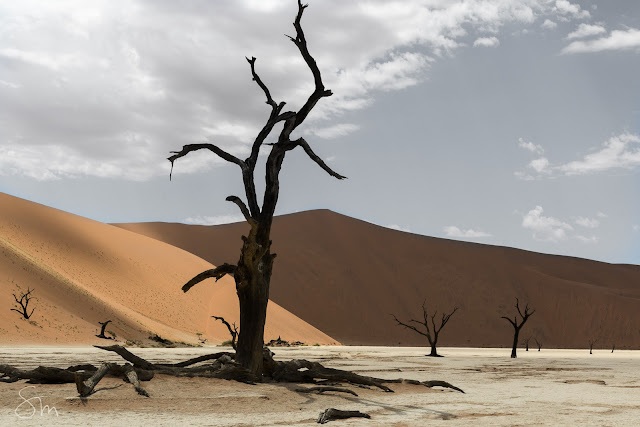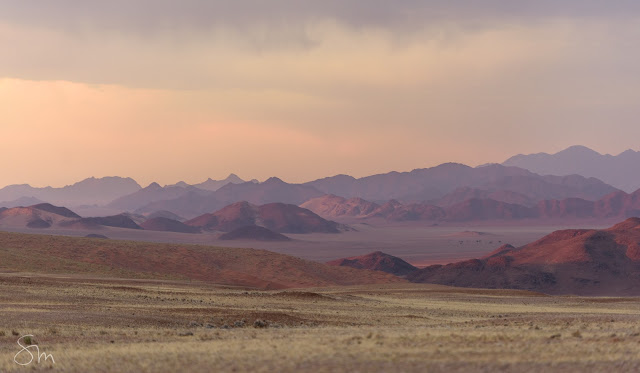Our last year's safari destination was Namibia. Even though I prefer to photograph animals in the wild and Namibia is supposedly devoid of many of the more spectacular animals sightings that you can have in East Africa, I found the countryside so versatile and inspiring that I easily adopted to the challenges to become a landscape photographer. With the occasional animal as a goodie or a focal point in its habitat.
We started from Windhoek, drove south towards the Kalahari, west to Sossusvlei and then north to Spitzkoppe and the Kaokoveld desert, on to the Skeleton coast, before ending our journey in Etosha National Park. Quite the usual circuit that mose tourists do who come here on self-drive vacations. And drive 2500 km in 10 days, and not on Autobahnen - puh... We came across red deserts, white deserts, yellow deserts, granite fields, boulders like in Australia's Uluru-region, pebbled coastlines, macchia, strange plants in barren stone deserts ... Namibia offers a basic course for the budding geologist, a geology 101, because its variety of formations mostly lie bare without vegetation in the dry glaring sun.
Let's start with the Kalahari desert, mostly red sand and dry savannah.
an off-road beetle's tracks?
it did rain a few drops
two days later the valley acquired a slightly greenish tint
The following pictures were taken around the Lodge on game drives which here they call "panorama" drives. Quite a fitting word.
On a hillside close by the lodge a bushman's cave can be visited with centuries-old cave drawings
We started from Windhoek, drove south towards the Kalahari, west to Sossusvlei and then north to Spitzkoppe and the Kaokoveld desert, on to the Skeleton coast, before ending our journey in Etosha National Park. Quite the usual circuit that mose tourists do who come here on self-drive vacations. And drive 2500 km in 10 days, and not on Autobahnen - puh... We came across red deserts, white deserts, yellow deserts, granite fields, boulders like in Australia's Uluru-region, pebbled coastlines, macchia, strange plants in barren stone deserts ... Namibia offers a basic course for the budding geologist, a geology 101, because its variety of formations mostly lie bare without vegetation in the dry glaring sun.
Let's start with the Kalahari desert, mostly red sand and dry savannah.
Driving can be a little adventurous
Eland antelope
an off-road beetle's tracks?
We stayed at the Kalahari Red Dunes Lodge. In the back you can see a tree with very extensive colonies of social weavers' nests.
Here at sunset:
The shadows and hues were so soft that I felt like seeing a huge L'Oreal ad.
Here at sunset:
From there we continued to Sossusvlei Desert Lodge along dusty dirt roads. Much of Namibia consists of large private fenced properties for agriculture or hunting. Sometimes a poor animal finds itself on the wrong side of the fence.
Without access to water it will very likely end up like this:
Every visitor to Namibia needs to see the famous dunes which feature prominently on every title page of any travel guide to Namibia, the Sossusvlei desert dunes and the Dead Vlei.
Most photographers try to be in the Sossusvlei and Dead Vlei area at sunrise or six a.m. when the doors to the Namib-Naukluft National Park open. As my husband is not a photographer and I don't always want to push him, we were late. However, the pictures turned out good enough (I think) - and we had the added bonus of avoiding the crowds. The day was overcast - the shadowplay of the clouds on the dunes was very rewarding to watch and photograph. It was very hot though, so there is something to be said for an earlier visit.
On the way to Sossusvlei :
The shadows and hues were so soft that I felt like seeing a huge L'Oreal ad.
a long tele lens is helpful
These dunes are huge. Many people climb them, but beware of the heat! A guide later told us of daily heatstroke victims who come unprepared with no water and no hat.
The Dead Vlei with its unique set of dead trees in a crater-like environment, white sand surrounded by red dunes.
dizzy?
a bushman's natural water source, the nara fruit
The Sossusvlei Desert Lodge, where we stayed, has a phantastic location. Although a bit off from the entrance to the National Park, the view from the terrace and from every room with its vastness towards this interesting cone-shaped hill is something I could watch all day long. I took dozens of photos of the view over the course of a few days -
The following pictures were taken around the Lodge on game drives which here they call "panorama" drives. Quite a fitting word.
macros from the rocks
On a hillside close by the lodge a bushman's cave can be visited with centuries-old cave drawings
the same weaver-nest tree with backlight (above) and silhouette lighting
.. to be cont'd...









































































